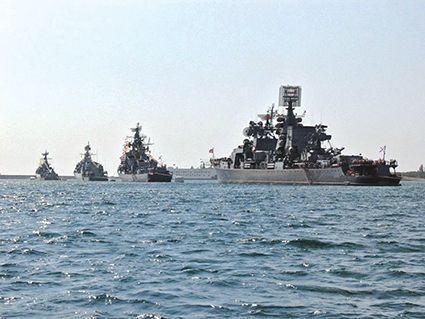Black Sea Security Dimension: Russia’s Military Hegemonization in Action?
Due to the strained relations between the West and Russia, including an ongoing economic war between the EU and the USA and Russia via a sanction policy and ever worsening confrontation between NATO and Russia via the constant flexing of “military muscles” between competing forces, there is many a thing a little country like Georgia has to think of. In that scope, one of the dangerous “combat zones” is thought to be the Black Sea Basin and its littoral territories aptly labeled as the “Black Sea Security Dimension.” The unpredictable geostrategic environment in the area is susceptible to deteriorating further and the indication that this might happen in the immediate future derive from actions taken by the Kremlin’s incumbent authority.
On July 27th 2015 a new naval doctrine was announced and later approved by the President of the Russian Federation. This document has identified a new interpretation of the military doctrine that was approved by the National Security Council in December 2015, underlining the importance of maintaining control over strategic areas and basins, such as the Artic and the so-called “Atlantic” direction, which includes the Black Sea basin. The doctrine also underlines the role of the fleet (both military and civilian), the shipbuilding industry, harbors and port infrastructure as priorities for the further development of Russia’s naval economy.
It appears Russia is trying to position itself as a great power with the ability to increase its military capability on the axis of the Caspian-Black-Mediterranean seas. The focal point of said axis is the Black Sea, a basin in which NATO influence is under threat of waning. The Russian policy-makers seek to regain the status-quo through domination in the basin by controlling three key points: Crimea, the mouths of the Danube and the Bosphorus.
Considering the latest events, Russia has partially achieved its strategic goals – first occupying and then annexing Crimea and reinforcing military positions in the peninsula, with the creation of the so-called “Mediterranean Task Force” within the Black Sea Fleet, and detachment of combat ships and boats for the Mediterranean Sea and the Gulf region to pursue its second objective of obtaining control over the Bosphorus (the Task Force was reinforced by the massive submarine “Rostov-on-Don,” which sailed from Novorosiisk to join the Force, equipped with the latest strategic weaponry system – the infamous “Kolibr” missiles).
With this reinforcement of its naval forces, Russia is not so far away from securing the third pillar of its strategy – the mouth of the Danube. Before that, however, in order to better reinforce its presence in the Black Sea basin, the Russian authority announced that 30 new ships are to be added to the Black Sea Fleet, including six new frigates, six new submarines and other smaller vessels for naval landing. In addition to that the Black Sea Fleet will reinforce its anti-access strategy (A2/AD) against NATO forces. Moreover, according to the “Jamestown Foundation,” official Moscow is adamant on setting up in Crimea an “unapproachable fortress” and military key-spot.
With the subsequent creation of two batteries of strategic strike rocket complex “ISKANDER-M,” targeting Georgia and Ukraine, it becomes clear that Russia has sufficient military prowess to “operate” at its whim in the Black Sea security dimension. Whether this military “muscle-show” will be enough to impress its neighbors remains to be seen. But the Kremlin’s decision to launch unprecedented massive military drills “KAVKAZ-2016” (now in its second phase) with the involvement of 11 thousand servicemen and usage of S-300M air-defense complexes, SU-34 jets, tactical-operational rocket systems “ISKANDER-M”, etc. means that Russia seriously considers beginning a new war campaign in the region in any direction should the chance to do so present itself.
According to Warsaw-based magazine: “New Eastern Europe,” the Russian government is set to spend USD 2.4 billion by 2020 to provide its Black Sea Fleet with “state-of-the-art” ships, submarines, air defense systems and naval infantry. Similarly, the Caspian Fleet is being reinforced with new military ships and vessels equipped with sea-to-sea and sea-to-land cruise missiles “Kolibr” and “Bulava,” even covering the operational tactical zone in Syria and Iraq.
Taking together all these factors, and paying attention to the regional security environment, the Black Sea Fleet is going to have full control over the Black Sea by 2020. In that retrospective provision, the military balance, that at present between the NATO and Russian forces is somewhere in proportion of 2:1 in favor of NATO, will see to it that in 2020 the balance will be absolutely opposite - same proportion, but in Russia’s favor. In that configuration, Georgia is in a dangerous position due to its littoral space and its sea ports that Russia will needs badly to establish its hegemony in. Hence, the Georgian Government and society will have to be very attentive toward any provocations stemming from the Russian side.
Vakhtang Maisaia












